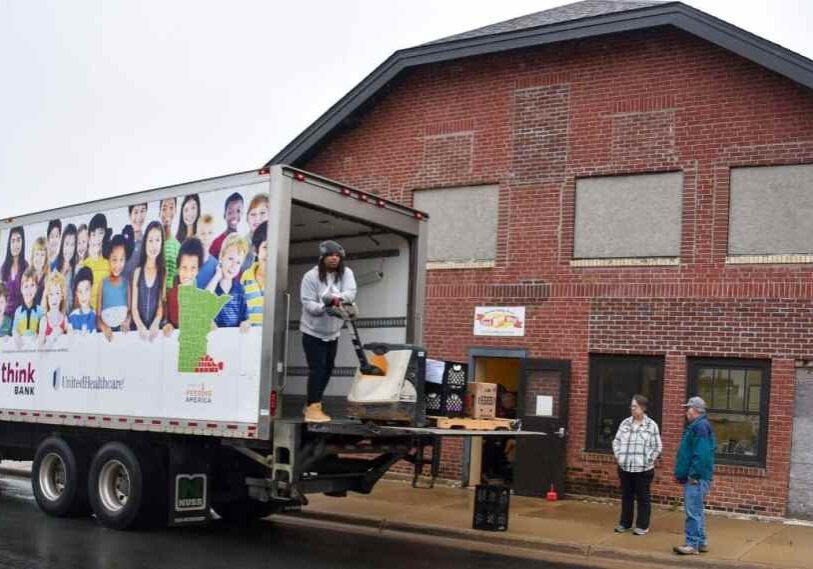Harmony Annexes 60 Acres for Possible Data Center
Citizens wonder what it might mean to them and their picturesque town

HARMONY, MINN.— At its October 14 meeting, the five-member Harmony City Council voted unanimously to annex 60 acres north of town into its city limits. This is the first step in a process that may lead to a data center being built in this community of 1,004 people. The site is located on Fillmore County Road 22 adjacent to the Dairyland Power Company Service Center.
Citizens first learned about the project during an October 7 Town Hall meeting sponsored by the Harmony Economic Development Authority (EDA). The meeting, attended by more than 100 people, was intended to inform community members about data centers and give city leaders and MiEnergy Cooperative officials a chance to share information about the proposed project.
Speaking at the Town Hall, Kent Whitcomb, MiEnergy’s vice president of member services, described a data center as a super library for digital information. “Whether that’s creating data, storing data, or processing data, it’s all done on servers at data centers,” he said.
These centers enable modern digital services – cloud computing, social media, banking, government operations, crypto currency, schools, restaurants, gas stations, individual homes and more – to function.

Presenters at the October 7 Town Hall included (left to right) Alissa Stelpflug, Harmony city administrator; Katrina Hurley, EDA coordinator (Community & Business Development Specialist, CEDA); an unnamed representative from Dairyland Power Cooperative; Christopher Giesen, manager, community & economic development, Dairyland Power Cooperative; Brian Krambeer, CEO, MiEnergy Cooperative; Kent Whitcomb, vice president member services, MiEnergy Cooperative; and Harmony Mayor Steve Donney (speaking). (Photo by Julie Little)
“We need growth,” said MiEnergy’s President and CEO Brian Krambeer. “There are transmission lines already in the area and the location provides an opportunity for MiEnergy to build a new substation to make use of the power already available through Dairyland Power.
“Harmony is also located in the middle of Winona State University, Luther College and Mayo Clinic,” Krambeer said, and “all of them have been looking to outsource some of their data storage.”
Katrina Hurley, coordinator of the Harmony EDA, talked about the benefit of a data center to the city. “A project in this field can serve as critical infrastructure to attract new technology-based investment, create reliable energy partnerships, and strengthen our local grid resilience.
“The EDA,” Hurley continued, “hopes to gain potential tax revenue, some jobs during construction, and increased visibility as a community open to innovation.”
Despite these more positive thoughts from presenters at the Town Hall, the meeting was dominated by questions and concerns from community members. The capacity crowd forced the meeting to be changed from the city’s council chambers to the community center gymnasium.

A flyer promoting the Town Hall held in early October. (From the Harmony EDA website)
October 7 Town Hall Q&A
The Town Hall presentation generated several questions voicing concerns from the audience.
What kind of electricity rate are you anticipating per kilowatt hour for the data center?
Krambeer answered that they are looking at a direct market rate. Data centers would run or shut down depending on what the price per hour was. MiEnergy would be sending the data center a signal like they send to all of their members when there is a peak use period.
What kind of jobs would there be and how many would go to local residents?
Chris Giesen, manager of Dairyland Community & Economic Development, said it depends on the type of project – maybe half a dozen. “These centers don’t require a lot of jobs, they’re automated,” he said.
There’s a fair amount of reporting in Minnesota papers where cities have signed nondisclosure agreements (NDA’s) to protect the identity of an entity that wants to build a data center. Has the City of Harmony or MiEnergy or Dairyland signed an NDA with anyone?
Harmony Mayor Steve Donney said that the City of Harmony has not signed an NDA and has not been approached to sign one. Krambeer said it’s the same for MiEnergy.
Would you be willing to sign one?
Krambeer said that MiEnergy is going to do its research to find out if it’s a company that we would really be interested in talking to and what their requirements are. He indicated that MiEnergy would be willing to consider signing one, but a lot depends on the city and what the requirements are.

Brian Krambeer, CEO MiEnergy Cooperative, told the Town Hall audience that the location on the north side of Harmony is ideal for a data center as the transmission lines are already in the area, making use of the power already available. (Photo by Julie Little)
What are the benefits for the taxpayers and what are the costs?
Mayor Donney said that in his opinion there won’t be any upfront costs. Most costs are borne by the businesses that would come in and use the center.
Will an Environmental Impact Statement study be required for this type of business?
“Not that I’m aware of,” said Mayor Donney. Whitcomb added that any business would have to follow the state of Minnesota laws with permits and the city would have its zoning code. [It was noted by a citizen that there are two pending lawsuits in Minnesota filed by the Minnesota Center for Environmental Advocacy (MCEA) to halt proposals because the data centers have not completed legally required full environmental reviews.]
Data centers in some places have not been good neighbors. With deep pockets, big law firms and shell companies, they might try to skirt rules or even violate them; one concern is that with those resources they can do whatever they want wherever they go. This community is right to question and worry and I’m hearing that you’re not caring or really responding to that.

Harmony EDA Coordinator Katrina Hurley explained at the Town Hall that a project of this kind can attract new technology-based investment and create reliable energy partnerships. (Photo by Julie Little)
EDA’s Hurley said the City of Harmony is being proactive about this. It’s up to the Planning and Zoning Board and the City to put in necessary parameters. Right now, she said, we are looking at what we have in place to protect Harmony and our natural resources because we want to put Harmony first and the residents first.
The Harmony EDA website will have regular updates on this project on a ‘Data Center’ section within the ‘Ongoing Projects’ page. Hurley encouraged residents to stay informed, ask questions and share feedback. “Your voices help guide our decisions.”
Data center options
MiEnergy is planning on a small to mid-size modular data center or possibly a mid-size edge center for data storage. Modular data centers are prefabricated units that house all the services, such as servers, power systems and coolers, for a data center – they are designed to be deployed quickly, while edge centers are more substantial structures.
Whitcomb says MiEnergy would require any data center that is located in Harmony to shut down during peak energy times or have backup generators to continue operating.

This modular data center in Lawler, Iowa is similar to what might be built near Harmony. Modular data centers are prefabricated units that can be erected quickly. (Photo by Dennis DeKeyrel)
MiEnergy would also target data centers that use a cooling system that does not draw water from aquifers. These would be air-cooled (fans) or a ‘closed loop’ liquid cooling system where the coolant is reused but cooled in between.
The Harmony data center would use up to 20 of the 60 acres with the remaining acreage possibly hosting a solar array (MiEnergy needs to generate 100 percent of its energy through renewable sources by 2040).
Krambeer and Whitcomb showed the council an artist rendering with businesses at the road frontage, the data center and substation in the middle, a solar array in the northwest corner and room for other operations at the northeast corner.
Data centers are not without controversy and many residents of small towns like Pine Island north of Rochester are taking grassroots action (MCEA recently filed suit claiming the city’s environmental review of a 480-acre project was inadequate). Concerns range from massive energy and water use to noise, air and light pollution; from health issues and negative impact on wildlife to increases in local taxes and utility rates.
Harmony residents may also have concerns about how the center would change the ambience so near the bike trail and at the entrance to a town that benefits from tourism.

The C.H. Robinson Data Center in Oronoco, Minn. is an “edge data center” – an example of what a proposed data center might look like. These edge centers are more substantial structures to build and usually use 10 to 30 acres of space. (Photo by Julie Little)
Local environmental control
Any data center operation will have to comply with state and federal environmental guidelines, but there are loopholes and some companies may be willing to sidestep the rules and consider fines as a cost of doing business. This means the next steps in the project will be critical to a positive outcome.
Following annexation, Harmony Planning & Zoning will be tasked with approving a zoning change for the proposed site from agricultural to industrial. It will also need to write the rules governing data centers into a citywide ordinance, which the city council would need to approve.
Whitcomb said that the City of Harmony has all the control in this process. Its tools include setbacks and screenage requirements, water usage and noise limits, growth limits, waste regulations, and more. Krambeer reiterated that the zoning process is very important and that MiEnergy looks forward to working with the zoning board in creating benchmarks.
Citizens requested a place at the table and Jesse Grabau of Planning & Zoning said all their meetings are open to the public. “Please come and participate,” he encouraged. Meetings are held the first Wednesday of every month at 7 p.m.
MiEnergy has an option to purchase the 60-acre site, but there is no corporate end-user identified for the project at this time – nor is there any expectation that the project will create many jobs, apart from a few employees for maintenance and security. And if the project does not go through, the 60 acres can be de-annexed from the city.
Like a blind date?
For many of the citizens in Harmony, supporting a data center in its city is like going on a blind date – many pending questions: What do they want to do? Why do they want to do it? Who will it benefit? Who will pay the price? Will it give Harmony and MiEnergy the solid partner they seek or will they come to wish they’d never met?
Like any blind date, it can turn out to be a good fit or a bad one. The real work begins now to figure that out.
University of Minnesota Extension’s Southeast (SE) Regional Sustainable Development Partnership (RSDP) is currently working with several local cities on guidance and tools to assist area communities approached with data center proposals. According to SE RSDP Executive Director Andi Sutton, this group is working together with others from the University’s Humphrey School of Public Affairs, the UMN Law School and staff from the Freshwater Society to look at the water and energy consumption of data centers. Representatives from Lewiston, Stewartville and Byron are collaborating with this team. Community conversations are planned for this winter; the team will also be looking at case study results from other states. The goal, Sutton says, is “to end with a set of decision-support tools for city leaders to help them be in a proactive negotiating position when data center developers approach them so that they are able to make good decisions both for their communities and the local ecosystem.” To learn more about the project, watch the 5-minute video below or visit this list of UMN MnDrive projects and scroll down to “Data Centers, Energy, and Water: Local Government Tools for Collective Planning and Community Decision-making in SE Minnesota.” For additional information or to engage with this project further, fill out this form.Regional Study Looking for Answers






